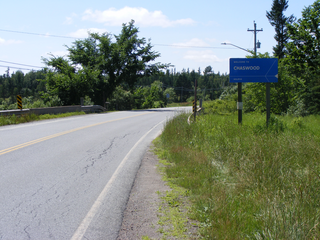Green Creek is a small community in the Canadian province of Nova Scotia, located in Colchester County.
Green Creek is a small community in the Canadian province of Nova Scotia, located in Colchester County.
Economy is an unincorporated rural community situated along the north shore of the Minas Basin/Cobequid Bay, at approximately 45°23'N, 63°54'W, in Colchester County, Nova Scotia. In the late 19th century, it was known for its shipbuilding industry.

Onslow is a rural, unincorporated Canadian community in central Colchester County, Nova Scotia. The community is located along the north bank of the Salmon River, opposite the town of Truro and is largely a farming area. The area was first settled by Acadians and resettled after their expulsion as Onslow Township in 1761 by Irish emigrants under Colonel McNutt. The township is believed to have been named after Arthur Onslow.

Chaswood is a rural community in the Musquodoboit Valley northwest of Middle Musquodoboit, Nova Scotia in Nova Scotia, Canada. Chaswood is named in honour of Charles Carroll Wood.
The Maccan River is a small tidal river contained completely within Cumberland County, Nova Scotia. The river terminates at the confluence of River Hebert at Amherst Point, and empties into the Cumberland Basin. The river's tidal bore may be viewed from the Tidal Wetlands Park in Maccan. According to estimates by the Province of Nova Scotia, there are 9,092 people resident within the Maccan/Kelly/Hebert watershed in 2011.
Maitland, East Hants, Nova Scotia is a village in East Hants, Nova Scotia. It is home to the historic Lawrence House Museum, which is part of the Nova Scotia Museum. The William D. Lawrence ship was built here. The community was part of the Douglas Township until it was named Maitland after Lieutenant Governor of Nova Scotia Peregrine Maitland (1828–34) when building the Shubenacadie Canal was first attempted (1826–1831). The Canal was supposed to start at Maitland, Nova Scotia and run through the province to Maitland Street, Dartmouth, the canal being "bookended" by two "Maitland" landmarks.
Upper Rawdon is a community in the Canadian province of Nova Scotia, located in the Municipal District of East Hants, which is in Hants County, Nova Scotia. This community was originally part of the Rawdon Township.
Glenholme is a community in the Canadian province of Nova Scotia, located in Colchester County.
Old Barns is a community in the Canadian province of Nova Scotia, located in Colchester County.

Port Howe is a community in the Canadian province of Nova Scotia, located in Cumberland County. The community is named after William Howe, 5th Viscount Howe.
Selma is a small community in the Canadian province of Nova Scotia, located in The Municipality of the District of East Hants in Hants County.
Green Oaks is a small rural community in the Canadian province of Nova Scotia, located in Colchester County.
Victoria is a community in the Canadian province of Nova Scotia, located in Cumberland County.
Thomson Station is a small community in the Canadian province of Nova Scotia, located in Cumberland County.
Folly Mountain is a mountain and a community in the Canadian province of Nova Scotia, located in Colchester County on Trunk 4 in the Cobequid Hills.
Mill Creek is a small community in the Canadian province of Nova Scotia, located in Cumberland County.
There are various Black Lakes in Nova Scotia, Canada. They vary widely in size, depth and usability. Many counties, such as Cumberland, Halifax, Inverness, and Pictou Counties have more than one Black Lake so named, while other counties mentioned in this article have only one named Black Lake.
The River Philip is a river contained entirely within Cumberland County, Nova Scotia, Canada.

The Stewiacke River is a river in the Canadian province of Nova Scotia that starts at Round Lake in Pictou County and flows into the Shubenacadie River in Colchester County running through the Stewiacke Valley.
The Stewiacke Valley is a Canadian rural region in central Nova Scotia running from western Pictou County through southern Colchester County to the Shubenacadie River.

A township in Nova Scotia, Canada, was an early form of land division and local administration during British colonial settlement in the 18th century. They were created as a means of populating the colony with people loyal to British rule. They were typically rural or wilderness areas of around 100,000 acres (400 km2) that would eventually include several villages or towns. Some townships, but not all, returned a member to the General Assembly of Nova Scotia; others were represented by the members from the county. Townships became obsolete by 1879 by which time towns and counties had become incorporated.
45°14′45.96″N63°23′46.55″W / 45.2461000°N 63.3962639°W